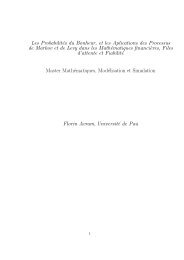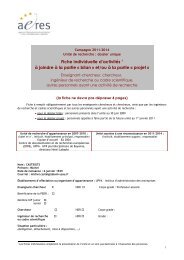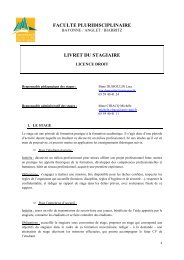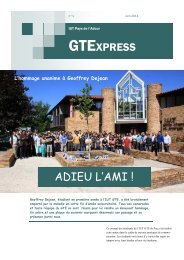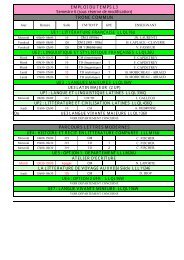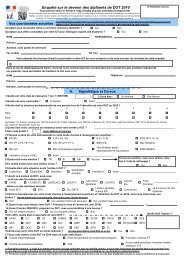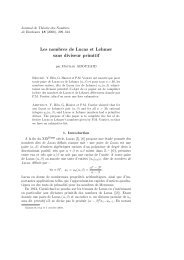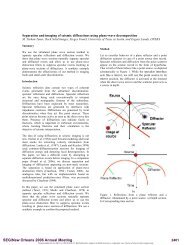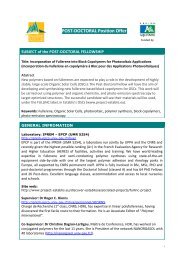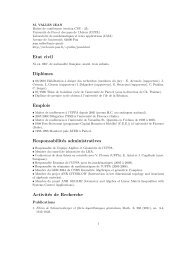Processus de Markov, de Levy, Files d'attente, Actuariat et Fiabilité ...
Processus de Markov, de Levy, Files d'attente, Actuariat et Fiabilité ...
Processus de Markov, de Levy, Files d'attente, Actuariat et Fiabilité ...
Create successful ePaper yourself
Turn your PDF publications into a flip-book with our unique Google optimized e-Paper software.
FILES D’ATTENTE, FIABILITÉ, ACTUARIAT<br />
Note, by the Pollaczek-Khinchine formula (4.9), that the ultimate ruin probabilities are<br />
in<strong>de</strong>pen<strong>de</strong>nt of c, once ρ is fixed (since they are compl<strong>et</strong>ely <strong>de</strong>termined by φ(s)). The classical<br />
Cramer Lundberg mo<strong>de</strong>l is thus overparam<strong>et</strong>erized as far as ultimate ruin probabilities are<br />
concerned, and by scaling time we may normalize any nonzero param<strong>et</strong>er like c or λ to be 1.<br />
Exercice 4.7.1 Soit Y (t) un processus <strong>de</strong> Cramér-Lundberg Y (t) = u+c t−C(t), C(t) =<br />
∑ N(t)<br />
i=1 Z i, où N(t) est un processus <strong>de</strong> Poisson d’intensité λ = 1, <strong>et</strong> les sinistres Z i ont une<br />
distribution hyperexponentielle ¯F(x) = 1 6 e−2x + 5 6 e−6x .<br />
a) Calculez l’espérance <strong>de</strong>s sinistres m 1 = EZ 1 <strong>et</strong> le taux <strong>de</strong> profit p = c − λm 1 , si le<br />
taux <strong>de</strong> cotisation est c = 3m 1 /2.<br />
b) Calculez la probabilité <strong>de</strong> ruine ψ(u), à partir <strong>de</strong> la formule <strong>de</strong> Pollaczek-Khinchin<br />
pour sa transformée <strong>de</strong> Laplace<br />
ψ ∗ (s) = 1 s − p<br />
κ(s) ,<br />
où le symbole/exposant <strong>de</strong> Lévy est κ(s) = s ( c − λ ¯F ∗ (s) ) . R : 5 9 e−x + 1 9 e−4x<br />
Exercice 4.7.2 Calculez la probabilité <strong>de</strong> ruine ψ(u) pour un processus <strong>de</strong> Cramér-Lundberg<br />
Y (t) = u+c t−C(t), C(t) = ∑ N(t)<br />
i=1 Z i, où N(t) est un processus <strong>de</strong> Poisson d’intensité λ =<br />
1, c = 8/5m 1 , <strong>et</strong> les sinistres Z i ont une distribution hyperexponentielle ¯F(x) = 1 4 e−2x + 3 4 e−4x .<br />
Exercice 4.7.3 Calculez la probabilité <strong>de</strong> ruine ψ(u) pour un processus <strong>de</strong> Cramér-Lundberg<br />
Y (t) = u + c t − C(t), C(t) = ∑ N(t)<br />
i=1 Z i, où N(t) est un processus <strong>de</strong> Poisson d’intensité<br />
λ = 1, c = 10/7m 1 , <strong>et</strong> les sinistres Z i ont une distribution hyperexponentielle ¯F(x) =<br />
1<br />
9 e−2x + 8 9 e−5x .<br />
Exercice 4.7.4 Calculez la probabilité <strong>de</strong> ruine ψ(u) pour un processus <strong>de</strong> Cramér-Lundberg<br />
Y (t) = u + c t − C(t), C(t) = ∑ N(t)<br />
i=1 Z i, où N(t) est un processus <strong>de</strong> Poisson d’intensité<br />
λ = 1, c = 4/3m 1 , <strong>et</strong> les sinistres Z i ont une distribution hyperexponentielle ¯F(x) = 1<br />
15<br />
16 e−6x .<br />
16 e−2x +<br />
Exercice 4.7.5 Calculez la probabilité <strong>de</strong> ruine ψ(u) pour un processus <strong>de</strong> Cramér-Lundberg<br />
Y (t) = u+c t−C(t), C(t) = ∑ N(t)<br />
i=1 Z i, où N(t) est un processus <strong>de</strong> Poisson d’intensité λ =<br />
1, c = 5/3m 1 , <strong>et</strong> les sinistres Z i ont une distribution hyperexponentielle ¯F(x) = 1 3 e−2x + 2 3 e−5x .<br />
Remarque 4.7.1 The formula (4.15) may be expan<strong>de</strong>d in a geom<strong>et</strong>ric series, leading finally<br />
to the ”Benes lad<strong>de</strong>r <strong>de</strong>composition formula” :<br />
with<br />
ψ(x) =<br />
∞∑<br />
(1 − ψ(0))ψ(0) n b e (x) ∗n (4.21) BPK<br />
n=1<br />
ψ(0) = λEC 1<br />
c<br />
= (1 + θ) −1 := ρ<br />
(the i<strong>de</strong>a behind this is that the appearance of each new lad<strong>de</strong>r is equivalent to the event of<br />
ruin starting from 0).



